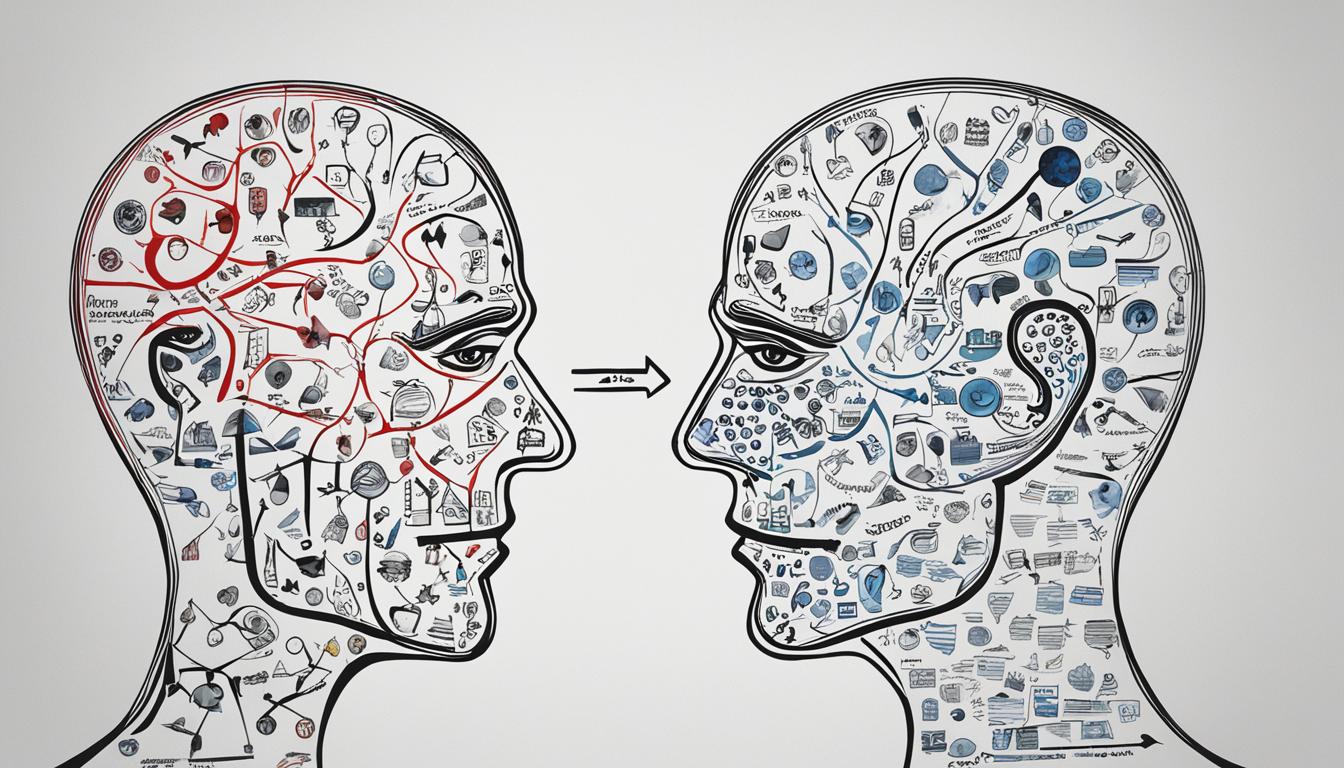Did you know that it is possible for an individual to have both Borderline Personality Disorder (BPD) and Narcissistic Personality Disorder (NPD) at the same time? When these two personality disorders coexist, they present specific treatment challenges and complexities. Thankfully, there are effective therapies and techniques to help manage the combination of BPD and NPD, giving hope to those seeking solutions.
Key Takeaways:
- Co-occurring BPD and NPD pose significant challenges in diagnosis and treatment due to overlapping symptoms and complex relationship dynamics.
- Therapeutic approaches such as dialectical behavioral therapy (DBT) and cognitive behavioral therapy (CBT) have demonstrated effectiveness in managing both disorders.
- Medication may be used to target specific symptoms or co-occurring mental health conditions, but it is not the primary treatment for BPD or NPD.
- An integrated treatment approach that combines individual therapy, group therapy, and family therapy is beneficial in addressing the complexities of co-occurring BPD and NPD.
- Supporting loved ones with co-occurring BPD and NPD requires education, setting boundaries, and providing emotional support.
Understanding BPD and NPD
Both Borderline Personality Disorder (BPD) and Narcissistic Personality Disorder (NPD) are personality disorders with overlapping symptoms and characteristics. BPD is characterized by unstable relationships, mood swings, fear of abandonment, and self-destructive behaviors. NPD, on the other hand, is characterized by a grandiose sense of self-importance, lack of empathy, and a need for admiration.
When these two disorders co-occur, individuals may experience intensified symptoms and complexities in diagnosis and treatment. The combination of BPD and NPD can create unique challenges for individuals and their loved ones, requiring a comprehensive and targeted approach to therapy and support.
A Comparison of BPD and NPD:
| Borderline Personality Disorder (BPD) | Narcissistic Personality Disorder (NPD) |
|---|---|
| Unstable relationships | Grandiose sense of self-importance |
| Mood swings | Lack of empathy |
| Fear of abandonment | Need for admiration |
| Self-destructive behaviors |
As seen in the comparison above, BPD and NPD display distinct traits, but they can also share commonalities. The presence of both disorders requires careful evaluation and personalized treatment plans to address the specific needs of the individual.
“The combination of BPD and NPD can create unique challenges for individuals and their loved ones, requiring a comprehensive and targeted approach to therapy and support.”
In the next section, we will explore the challenges involved in diagnosing and treating the co-occurrence of BPD and NPD, shedding light on the complexities faced by clinicians and offering insights into effective therapeutic interventions.
Challenges in Diagnosing and Treating Co-occurring BPD and NPD
Diagnosing and treating individuals with co-occurring borderline personality disorder (BPD) and narcissistic personality disorder (NPD) presents unique challenges. These two personality disorders share similarities in symptoms, making it difficult to differentiate between the two. Additionally, the ego-syntonic nature of these disorders can hinder individuals from recognizing the need for treatment.
People with NPD may exhibit traits of BPD, further complicating the diagnostic process. The overlapping symptoms can blur the lines between these disorders, requiring careful assessment and evaluation by mental health professionals.
Treatment challenges arise when addressing the dual diagnosis of BPD and NPD. Those with NPD may have a resistance to treatment and poor insight into their behaviors, making therapeutic progress more challenging. The complex relationship dynamics associated with these disorders, including potential manipulation and a lack of empathy, also present obstacles for effective treatment.
“Diagnosing and treating individuals with co-occurring BPD and NPD requires a comprehensive and nuanced approach. Understanding the intricacies of both disorders and the complexities they bring to the treatment process is crucial for achieving positive outcomes.”
In overcoming these challenges, mental health professionals must employ an integrated treatment approach that addresses both BPD and NPD concurrently. This may involve utilizing evidence-based therapeutic modalities that focus on emotion regulation, interpersonal skills development, and challenging maladaptive thoughts and behaviors.
It is also vital to create a supportive and safe therapeutic environment where individuals can explore underlying themes such as self-worth, ego-syntonic beliefs, and interpersonal difficulties. Establishing clear boundaries and addressing NPD traits such as manipulation and lack of empathy are essential aspects of the treatment process.
To illustrate the challenges faced in diagnosing and treating co-occurring BPD and NPD, the following table highlights some key contrasts:
| BPD | NPD |
|---|---|
| Turbulent interpersonal relationships | Grandiose sense of self-importance |
| Emotional instability | Lack of empathy |
| Fear of abandonment | Need for admiration |
| Self-harming behaviors | Exploitative behavior |
Note: The table showcases some general differences between BPD and NPD. Please consult a mental health professional for accurate diagnosis and treatment recommendations.
Overcoming the challenges in diagnosing and treating co-occurring BPD and NPD requires a collaborative effort between individuals, their loved ones, and mental health professionals. By acknowledging the complexities of these disorders and implementing comprehensive treatment strategies, individuals can find hope, healing, and improved quality of life.

Therapeutic Approaches for Co-occurring BPD and NPD
When it comes to treating individuals with co-occurring Borderline Personality Disorder (BPD) and Narcissistic Personality Disorder (NPD), psychotherapy is the primary therapeutic intervention. Two commonly used approaches in this integrated treatment approach are Cognitive Behavioral Therapy (CBT) and Dialectical Behavioral Therapy (DBT).
Cognitive Behavioral Therapy (CBT) focuses on helping individuals challenge maladaptive thoughts and beliefs, promoting healthier cognitive patterns. By identifying and modifying negative thinking patterns, individuals can gain better control over their emotions and behaviors. CBT can be particularly beneficial in addressing NPD traits such as grandiosity and a need for admiration.
Dialectical Behavioral Therapy (DBT) places emphasis on emotion regulation, interpersonal effectiveness, distress tolerance, and mindfulness. This therapy helps individuals with BPD and NPD develop more adaptive coping strategies for regulating their intense emotions and managing interpersonal relationships effectively.
The integration of these therapeutic approaches acknowledges and targets the unique challenges and core features of both BPD and NPD. By combining CBT and DBT, individuals receive a comprehensive treatment program that addresses their specific needs.
Integrated Treatment Approach
An integrated treatment approach combines multiple therapeutic modalities to provide a holistic and individualized approach to co-occurring BPD and NPD. This approach may involve:
- Individual therapy: One-on-one sessions with a therapist to address personal challenges, develop insight, and work on individual goals.
- Group therapy: Participation in group sessions with individuals who have similar diagnoses, providing opportunities for peer support, social skills practice, and learning from others’ experiences.
- Family therapy: Inclusion of family members in therapy sessions to address family dynamics, communication patterns, and enhance understanding and support.
By combining these therapeutic modalities, the integrated treatment approach aims to address the complex dynamics and relationships associated with co-occurring BPD and NPD.
Therapeutic Approaches for BPD and NPD – Summary
“Psychotherapy, particularly Cognitive Behavioral Therapy (CBT) and Dialectical Behavioral Therapy (DBT), are effective therapeutic interventions for individuals with both BPD and NPD.”
In summary, therapeutic interventions for co-occurring BPD and NPD focus on addressing the unique challenges posed by these disorders. By integrating Cognitive Behavioral Therapy (CBT) and Dialectical Behavioral Therapy (DBT) into an individualized treatment plan, individuals can improve their emotion regulation, develop interpersonal skills, and challenge maladaptive thoughts and beliefs. The combined use of individual therapy, group therapy, and family therapy offers a comprehensive approach to address the complex dynamics associated with co-occurring BPD and NPD.

BPD and NPD Therapeutic Approaches – A Comparative Look
| Therapeutic Approaches | Focus | Benefits |
|---|---|---|
| Cognitive Behavioral Therapy (CBT) | Challenging maladaptive thoughts and beliefs |
|
| Dialectical Behavioral Therapy (DBT) | Improving emotion regulation and interpersonal skills |
|
As shown in the table above, both CBT and DBT offer unique benefits and focus areas. CBT is effective in challenging maladaptive thoughts and beliefs, while DBT focuses on improving emotion regulation and interpersonal skills. The combination of these approaches creates a comprehensive method for managing the symptoms and complexities of co-occurring BPD and NPD.
Medication for Co-occurring BPD and NPD
When it comes to treating co-occurring borderline personality disorder (BPD) and narcissistic personality disorder (NPD), medication is not the primary focus. These disorders are primarily managed through psychotherapy and other forms of mental health treatment. However, medication can play a role in addressing specific symptoms or co-occurring mental health conditions that may accompany BPD or NPD.
When considering medication for co-occurring BPD and NPD, it is important to conduct a comprehensive assessment and collaborate with a psychiatrist. Together, you and your healthcare provider can determine if medication is appropriate and if it can help target specific symptoms or conditions such as depression, anxiety, or bipolar disorder. It is crucial to closely monitor for any potential side effects or interactions.
It’s important to note that medication should be used as an adjunctive treatment, meaning it should be combined with psychotherapy and other therapeutic approaches. Medication alone is not a standalone solution for managing BPD or NPD, but it can be a helpful component of a comprehensive treatment plan.

Pros and Cons of Medication for BPD and NPD
Like any form of treatment, medication for co-occurring BPD and NPD comes with both benefits and potential drawbacks. Here are some pros and cons to consider:
| Pros | Cons |
|---|---|
|
|
Ultimately, the decision to use medication as part of the treatment plan for co-occurring BPD and NPD should be made in consultation with a psychiatrist or healthcare provider. They can help weigh the potential benefits and risks to determine if medication is appropriate for your unique situation.
Addressing Co-occurring NPD in BPD Treatment
When managing individuals with co-occurring Borderline Personality Disorder (BPD) and Narcissistic Personality Disorder (NPD), our approach must encompass both disorders simultaneously. We recognize the importance of delving into underlying themes of self-worth, ego-syntonic beliefs, and challenges in interpersonal relationships to provide effective therapy for BPD and NPD.
Our primary goal is to create a safe and supportive environment where individuals can explore their emotions and develop insight into their thoughts and behaviors. Therapists focus on helping individuals enhance their emotional regulation skills and cultivate more adaptive coping strategies.
Addressing NPD traits, which may include a lack of empathy and manipulative tendencies, presents unique challenges. Nonetheless, we prioritize setting appropriate boundaries and fostering healthy relationship dynamics within the therapeutic setting.
| Treatment Approach | Description |
|---|---|
| Individual Therapy | One-on-one sessions allow for personalized exploration of emotions and thought patterns. |
| Group Therapy | Participating in group sessions offers individuals the opportunity to practice healthy social interactions and learn from peers. |
| Family Therapy | Involving families in therapy can aid in addressing complex relationship dynamics and promoting understanding and support. |
Our comprehensive therapeutic approach aims to foster growth, insight, and emotional well-being for individuals with co-occurring NPD in BPD treatment.

Long-Term Outlook and Prognosis
The long-term prognosis for individuals with co-occurring Borderline Personality Disorder (BPD) and Narcissistic Personality Disorder (NPD) can vary depending on several factors. These factors include the severity of symptoms, the presence of other comorbid mental health conditions, and the level of motivation for treatment.
Research suggests that when BPD symptoms persist and do not remit, the co-occurrence of NPD is more likely. These individuals may face additional challenges in maintaining stable relationships and may exhibit higher levels of aggression and interpersonal difficulties.
Long-term therapy and support are crucial in assisting individuals in managing their symptoms and improving their overall functioning. By addressing the root causes of both disorders and developing coping strategies to navigate their challenges, individuals can have a better quality of life in the long term.
Factors Affecting Prognosis
Several factors can influence the long-term prognosis for individuals with co-occurring BPD and NPD:
- The individual’s commitment to therapy and willingness to engage actively in the treatment process
- The presence of other mental health conditions or substance use disorders
- The availability of a supportive social network and access to ongoing professional support
It is important to note that the prognosis can also be influenced by the effectiveness of the chosen therapeutic interventions and the skill and experience of the treating mental health professionals.
Long-Term Therapy and Support
Long-term therapy and support are essential for individuals with co-occurring BPD and NPD. The complex nature of these personality disorders requires ongoing treatment to address the underlying issues and develop healthy coping mechanisms.
Therapy modalities such as dialectical behavioral therapy (DBT) and cognitive behavioral therapy (CBT) have shown promise in effectively managing the symptoms of BPD and NPD. These therapies help individuals regulate their emotions, challenge maladaptive thoughts and behaviors, and develop healthier ways of relating to others.
Additionally, support groups and peer support programs can provide individuals with a sense of community and understanding. These forums allow for shared experiences, validation, and a space to learn from others who have faced similar challenges.
(Keyword) Personal Journey to Recovery
“Through long-term therapy and support, I have been able to navigate the challenges of co-occurring BPD and NPD. With the right treatment, I have learned healthier ways of relating to others and managing my emotions. It has been a personal journey to recovery, and I continue to work on my self-awareness and growth every day.”
For individuals with co-occurring BPD and NPD, the journey to recovery may be challenging but possible. With perseverance and a comprehensive treatment plan that includes therapy, support, and self-reflection, individuals can achieve long-term stability and improved well-being.

Supporting Loved Ones with Co-occurring BPD and NPD
Supporting a loved one with co-occurring borderline personality disorder (BPD) and narcissistic personality disorder (NPD) can be a challenging journey. It requires a multifaceted approach that combines empathy, understanding, and active involvement in their mental health treatment.
First and foremost, encouraging your loved one to seek professional help is essential. Connect them with mental health professionals who specialize in personality disorders. These experts have extensive knowledge and experience in managing the unique challenges posed by BPD and NPD. By guiding your loved one towards appropriate treatment options, you can help them embark on a path towards recovery and improved well-being.
Emotional support is crucial throughout this process. Show understanding and patience as your loved one navigates the complexities of their dual diagnosis. Act as a source of comfort by actively listening and providing reassurance. Offer validation and understanding, highlighting that their struggles are valid and that they are not alone in their journey.
Educating yourself about BPD and NPD is fundamental in understanding the experiences of your loved one. Familiarize yourself with the symptoms, challenges, and treatment approaches involved. This knowledge will enable you to provide informed support and engage in meaningful discussions about their mental health.
Setting boundaries is an important aspect of supporting someone with co-occurring BPD and NPD. Define and communicate your limits while maintaining empathy and compassion. Creating a healthy balance between supporting your loved one and prioritizing your own well-being is crucial.
“A journey of a thousand miles begins with a single step.” – Laozi
Open and honest communication is key in forging a strong support system. Encourage your loved one to share their thoughts, fears, and emotions with you. Foster an environment where they feel safe and heard. By promoting open dialogue, you can strengthen your bond and provide valuable guidance and encouragement.
Furthermore, seeking therapy or support groups for yourself can be beneficial. It enables you to navigate the complexities of supporting a loved one with dual disorders, seek advice from professionals, and find emotional support from individuals who share similar experiences.
To summarize, supporting a loved one with co-occurring BPD and NPD involves encouraging them to seek treatment, connecting them with specialists, providing emotional support, educating yourself, setting boundaries, fostering open communication, and seeking your own support. By implementing these strategies, you can make a lasting difference in the lives of those you care about, helping them navigate their mental health journey with compassion and understanding.
Treatment Options for Co-occurring BPD and NPD
| Treatment Approach | Description |
|---|---|
| Psychotherapy | A commonly used treatment option that includes dialectical behavioral therapy (DBT) and cognitive behavioral therapy (CBT). These therapies focus on improving emotion regulation, interpersonal skills, and challenging maladaptive thoughts and beliefs. |
| Medication | While there are no specific medications indicated for BPD or NPD, they may be used to target co-occurring mental health conditions or specific symptoms. Medication should be used in conjunction with psychotherapy and under the guidance of a healthcare professional. |
| Support Groups | Support groups provide a sense of community, allowing individuals to connect with others who understand their experiences. They offer a safe space to share, learn coping strategies, and receive validation and support. |
| Family Therapy | Involving family members in therapy can help address relationship dynamics, improve communication, and foster understanding and support for the individual with co-occurring BPD and NPD. |

Conclusion
Treating co-occurring borderline personality disorder (BPD) and narcissistic personality disorder (NPD) requires a comprehensive and individualized approach. Through evidence-based treatment, individuals with dual diagnosis can achieve improved quality of life and increased well-being.
Integrated treatment strategies that combine psychotherapy and, in some cases, medication can effectively address the challenges associated with both disorders. By addressing the symptomatology and underlying personality difficulties, therapists can help individuals develop the necessary skills for managing their conditions.
However, it’s important to note that the prognosis may vary, and ongoing therapy and support are essential for individuals with co-occurring BPD and NPD. Building a therapeutic environment that fosters growth and recovery is key to long-term success.
By implementing evidence-based treatment approaches, individuals with dual diagnosis can find hope in managing their symptoms, improving their relationships, and ultimately leading fulfilling lives.
FAQ
What are the challenges in treating co-occurring BPD and NPD?
Treating co-occurring BPD and NPD can be challenging due to the complex nature of these disorders, overlapping symptoms, and the ego-syntonic nature of NPD. There may also be resistance to treatment and difficulties in diagnosing and differentiating between the two disorders.
What are the therapeutic approaches for co-occurring BPD and NPD?
Therapeutic interventions such as dialectical behavioral therapy (DBT) and cognitive behavioral therapy (CBT) are commonly used for individuals with co-occurring BPD and NPD. These approaches focus on improving emotional regulation, developing interpersonal skills, and challenging maladaptive thoughts and beliefs.
Is medication used for treating co-occurring BPD and NPD?
Medication is not specifically indicated for BPD or NPD, but it may be used to target specific symptoms or co-occurring mental health conditions. However, medication should be used as an adjunctive treatment to psychotherapy and not as a standalone solution.
How can co-occurring NPD be addressed in BPD treatment?
Co-occurring NPD can be addressed in BPD treatment through creating boundaries, fostering healthy relationship dynamics, and addressing NPD traits such as lack of empathy and manipulation within the therapeutic setting.
What is the long-term outlook for individuals with co-occurring BPD and NPD?
The long-term outlook depends on various factors, but research suggests that when BPD symptoms persist and do not remit, the co-occurrence of NPD is more likely. Long-term therapy and support are crucial in managing symptoms and improving overall functioning.
How can I support a loved one with co-occurring BPD and NPD?
Supporting a loved one with co-occurring BPD and NPD requires a multifaceted approach. Encouraging them to seek treatment, connecting them with mental health professionals, and providing emotional support can make a significant difference. Educating yourself, setting boundaries, and engaging in open communication are also important.
What is the conclusion regarding managing BPD and NPD?
Managing BPD and NPD requires a comprehensive and individualized approach. By implementing evidence-based treatment approaches and addressing both the symptomatology and underlying personality difficulties, individuals with dual diagnosis can achieve improved quality of life and increased well-being.









